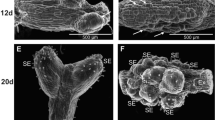Abstract
The effect of exogenously supplied reduced nitrogen and sucrose on high-frequency somatic embryogenesis in petiole-derived tissue cultures of a diploid and a tetraploid regenerable clone of Medicago sativa ssp. falcata was investigated. There was an absolute requirement for ammonium during embryo induction and differentiation, with 5mM being the optimum for induction and 10–20 mM the optimum for differentiation of somatic embryos. Exogenous amino acids were not essential for differentiation and often even inhibitory, except 1 or 2 g/l casein hydrolysate or 4.4 mM glutamine with 3.1 mM proline which, under certain conditions, resulted in increases of 20–30% in the number of embryos obtained. High and low sucrose concentrations inhibited somatic embryogenesis and there was no reason to deviate from the 3% (0.088 M) sucrose level commonly used in plant tissue culture media. Selected clones from three M. sativa cultivars showed a response similar to the highly regenerable ssp. falcata clone F1.1.
Similar content being viewed by others
References
Ammirato PV (1983) Embryogenesis. In: Evans DA, Sharp WR, Ammirato PV, Yamada Y (eds) Handbook of Plant Cell Culture, Vol. 1. New York: McMillan Publ Co p 82–105
Armstrong CL, Green CE (1985) Establishment and maintenance of friable embryogenic maize callus and the involvement of L-proline. Planta 164: 207–214
Ball E (1953) Hydrolysis of sucrose by autoclaving media, a neglected aspect in the technique of culture of plant tissues. Bull Torrey Bot Club 80: 409–411
Barns DK, Bingham ET, Murphy RP, Hunt OJ, Beard DF, Skrdla WH, Tenber LR (1977) Alfalfa germplasm in the United States: Genetic vulnerability, use, improvement, and maintenance. USDA Tech Bull p 1–21
Bister-Miel F, Guignard JL, Burey M, Agier C (1985) Glutamine as an active component of casein hydrolysate: Its balancing effect on plant cells cultured in phosphorus medium. Plant Cell Rep 4: 161–164
Britikov EA, Schrauwen J, Linskens J (1970) Proline as a source of nitrogen in plant metabolism. Acta Bot Neerl 19: 515–520
Dunwell JM, Thurling N (1985) Role of sucrose in microspore embryo production in Brassica napus ssp. oleifera. J Exp Bot 36: 1478–1491
Gleddie S, Keller W, Setterfield G (1983) Somatic embryogenesis and plant regeneration from leaf explants and cell suspensions of Solanum melonga (eggplant). Can J Bot 61: 656–666
Halperin W, Wetherell DF (1965) Ammonium requirement for embryogenesis in vitro Nature 205: 519–520
Kamada H, Harada H (1979) Studies on the organogenesis in carrot tissue cultures II. Effect of amino acids and inorganic nitrogenous compounds on somatic embryogenesis. Z Pflanzenphysiol 91: 453–460
Lamport DTA, Catt JW (1981) Glycoproteins and enzymes of the cell wall. In: Tanner W, Loewus FA (eds) Plant Carbohydrates II. Encyclopaedia of Plant Physiology, Vol 13. Berlin: B Springer Verlag, p 130–165
Le Redulier D Strom AR, Dandekar AM, Smith LT, Valentine RC (1984) Molecular biology of osmoregulation. Science 224: 1064–1068
Meijer EGM, Brown DCW (1985) Screening of diploid Medicago sativa for somatic embryogenesis. Plant Cell Rep 4: 285–289
Meijer EGM, Brown DCW (1987) A novel system for rapid high frequency somatic embryogenesis in Medicago sativa L. Physiol Plant 69: 591–596.
Murashige T, Skoog F (1962) A revised medium for rapid growth and bioassays with tobacco tissue cultures. Physiol Plant 15: 473–497
Nuti Ronchi V, Caligo MA, Nozzolini M, Luccarine G (1984) Stimulation of carrot somatic embryogenesis by proline and serine. Plant Cell Rep 3: 210–213
Skokut TA, Manchester J, Schafter J (1985) Regeneration in alfalfa tissue culture. Stimulation of somatic embryo production by amino acids and N-15 NMR determination of nitrogen utilization. Plant Physiol 79: 579–583
Stuart DA, Strickland SG (1984) Somatic embryogenesis from cell cultures of Medicago sativa L. I. The role of amino additions to the regeneration medium. Plant Sci Lett 34: 165–174
Stuart DA, Strickland SG (1984) Somatic embryogenesis from cell cultures of Medicago sativa L. II. The interaction of amino acids with ammonium. Plant Sci Lett 34: 175–181
Walker KA, Sato SJ (1981) Morphogenesis in callus tissues of Medicago sativa: The role of ammonium ions in somatic embryogenesis. Plant Cell Tissue Organ Cult 1: 109–121
Wetherell DF, Dougall DK (1976) Sources of nitrogen supporting growth and embryogenesis in cultured wild carrot tissue. Physiol Plant 37: 97–103.
Author information
Authors and Affiliations
Rights and permissions
About this article
Cite this article
Meijer, E.G.M., Brown, D.C.W. Role of exogenous reduced nitrogen and sucrose in rapid high frequency somatic embryogenesis in Medicago sativa . Plant Cell Tiss Organ Cult 10, 11–19 (1987). https://doi.org/10.1007/BF00037492
Received:
Accepted:
Issue Date:
DOI: https://doi.org/10.1007/BF00037492




